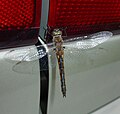| Epitheca | |
|---|---|
 | |
| Common baskettail | |
| Scientific classification | |
| Kingdom: | Animalia |
| Phylum: | Arthropoda |
| Class: | Insecta |
| Order: | Odonata |
| Infraorder: | Anisoptera |
| Family: | Corduliidae |
| Subfamily: | Corduliinae |
| Genus: | Epitheca Burmeister, 1839 |
| Type species | |
| Libellula bimaculata Charpentier, 1825 | |
Epitheca is a genus of dragonflies in the family Corduliidae. They are commonly known as baskettails. Baskettails' distinction is the specially adapted, upturned abdomen tip of the females which allows them to carry their egg masses in a small, orange-tinted globule. [1]
Contents
Some authorities spin off the North American baskettails into two new genera, Epicordulia and Tetragoneuria, but this has not gained widespread acceptance and most references place them under this genus. [2]









